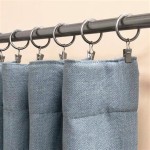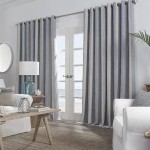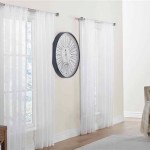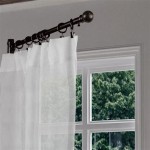Shower Curtain Length Considerations for Shower Stalls
Selecting the appropriate shower curtain length for a shower stall is crucial for maintaining bathroom hygiene, preventing water damage, and ensuring a visually appealing aesthetic. While standard bathtub shower curtains typically measure 70-72 inches in length, shower stalls often require different dimensions. Understanding the specific needs of a shower stall and considering factors such as ceiling height, rod placement, and personal preferences are essential for choosing the ideal shower curtain length.
A shower curtain primarily serves to contain water within the showering area, preventing splashes and leaks that can lead to mold growth, floor damage, and potential slip hazards. A properly sized shower curtain effectively achieves this goal while also contributing to the overall look and feel of the bathroom. Conversely, an incorrectly sized curtain can be both functionally ineffective and visually unappealing.
Standard shower stalls often present unique challenges when it comes to shower curtain selection. The dimensions of shower stalls can vary considerably, and the placement of the shower rod may differ from standard bathtub setups. Moreover, the presence of a shower base or lip can impact the required curtain length. Therefore, careful measurement and consideration of these factors are fundamental to selecting the correct shower curtain length.
Determining the Ideal Shower Curtain Length
The first step in determining the ideal shower curtain length for a shower stall is accurate measurement. This involves measuring the distance from the shower rod to the finished floor. It is important to use a measuring tape for precision and to take multiple measurements along the span of the shower rod, as slight variations in height can occur. The lowest measurement should be used as the basis for calculating the required shower curtain length.
Once the distance from the rod to the floor is established, adjustments must be made to accommodate the desired clearance. A small gap, typically ranging from 1 to 2 inches, between the bottom of the shower curtain and the floor is recommended. This clearance prevents the curtain from dragging on the floor, which can lead to accelerated wear and tear, mildew growth, and difficulty in cleaning. This clearance also allows for better air circulation, promoting quicker drying and reducing the likelihood of mold formation.
The presence of a shower base or lip should also be taken into account. If the shower stall features a raised threshold, the height of the base should be added to the floor-to-rod measurement. This ensures that the shower curtain extends far enough down to effectively contain water within the shower area. Neglecting to account for the shower base height can result in a curtain that is too short, rendering it ineffective in preventing water leakage.
Furthermore, the type of shower curtain rings or hooks used can impact the overall length. Different types of rings and hooks have varying drop lengths, which can either increase or decrease the effective length of the curtain. It is advisable to select the shower curtain rings or hooks before determining the final curtain length to ensure accurate calculations. Alternatively, the estimated drop length of the rings/hooks can be added to the calculated curtain length.
After measuring and accounting for clearance, shower base height (if applicable), and the type of rings/hooks, the ideal shower curtain length can be calculated. For example, if the distance from the rod to the floor is 75 inches, a 2-inch clearance is desired, and the shower base is 4 inches high, the required curtain length would be 75 inches + 4 inches - 2 inches = 77 inches. Therefore, a shower curtain with a length of approximately 77 inches would be suitable for this particular shower stall. In cases where an exact match is unavailable, rounding up to the nearest available length is often the best approach.
Shower Curtain Material and Weight Considerations
In addition to length, the material and weight of the shower curtain are important factors that influence its performance and suitability for a shower stall. Common shower curtain materials include vinyl, polyester, cotton, and various blends. Each material offers distinct advantages and disadvantages in terms of water resistance, durability, maintenance, and aesthetic appeal.
Vinyl shower curtains are known for their excellent water resistance and affordability. They are relatively easy to clean and maintain, making them a popular choice for many bathrooms. However, some vinyl curtains may contain PVC, which can release volatile organic compounds (VOCs). Opting for PVC-free vinyl alternatives can mitigate this concern.
Polyester shower curtains are a durable and water-resistant option that is often machine washable. They tend to drape well and are available in a wide range of colors and patterns. Polyester curtains are also less prone to mildew growth compared to some other materials.
Cotton shower curtains offer a more natural and aesthetically pleasing option. However, cotton is not inherently water-resistant and requires a waterproof liner to effectively prevent water leakage. Cotton curtains can also be more susceptible to mildew growth if not properly dried and maintained.
The weight of the shower curtain can also impact its performance. Heavier curtains tend to drape better and are less likely to billow inward during showering. This is particularly important in shower stalls with limited space, as billowing can be a nuisance and reduce showering comfort. Weight can be added through thicker material or through the use of weights sewn into the bottom hem of the curtain.
The choice of shower curtain material and weight should be based on a balance of factors, including budget, aesthetic preferences, maintenance requirements, and the specific needs of the shower stall. A consideration of these factors will ensure both functional effectiveness and aesthetic integration of the selected shower curtain.
Hardware and Installation Considerations
Selecting the appropriate hardware and ensuring proper installation are crucial for the successful use of a shower curtain in a shower stall. The type of shower rod used and the method of installation can significantly impact the curtain's stability, functionality, and overall appearance.
Shower rods are available in various materials, including metal, plastic, and wood. Metal rods, such as stainless steel or chrome, are generally the most durable and resistant to rust and corrosion. Plastic rods are a more affordable option but may be less durable. Wood rods can add a touch of elegance but require proper sealing to prevent water damage.
Shower rods can be installed using different methods, including tension mounting, screw mounting, and adhesive mounting. Tension rods are easy to install and require no drilling, but they may not be as stable as screw-mounted rods. Screw-mounted rods offer greater stability and can support heavier shower curtains, but they require drilling holes in the bathroom walls. Adhesive-mounted rods provide a compromise between ease of installation and stability, but it is important to choose an adhesive that is specifically designed for bathroom environments.
When installing a shower rod, it is important to ensure that it is level and securely fastened to the wall. A level rod will prevent the shower curtain from sagging or pulling to one side. Securely fastened rods will prevent them from falling down, especially when subjected to the weight of a wet shower curtain.
The selection of shower curtain rings or hooks should also complement the chosen shower rod and curtain. Different types of rings and hooks offer varying degrees of ease of use, durability, and aesthetic appeal. Roller rings allow the curtain to glide smoothly along the rod, while snap-on hooks provide a secure attachment. Decorative hooks can add a touch of personal style to the bathroom.
Proper installation of the shower rod and the selection of appropriate rings/hooks ensure that the shower curtain performs as intended and contributes to the overall functionality and aesthetic of the shower stall. Neglecting this element can lead to functional problems and detract from the bathrooms overall appearance.

Glacier Bay Peva Medium 5 Gauge Stall Liner 42 In W X 78 H Frosted

Liba Fabric Shower Curtain White Heavy Duty Water Repellent Soft Cloth Hotel Style Curtains

Zenna Home 54 In W X 78 H White Recycled Cotton 100 Waterproof Stall Sized Fabric Shower Curtain Liner With Anti Draft Clips 72674y54x78ywht

Most Popular Shower Curtain Sizes Measuring Tips

Evideco French Home Goods 72 In L X 48 W Small Stall Grey Shower Curtain Narrow Size 8 Matching Rings 1210180 The

Yisure Half Size Shower Curtain Narrow Stall Frost Peva W36xl84 Inch Long Length Liner

Madison Park Spa Waffle 54 In X 78 Silver Shower Curtain With 3m Treatment Mp70 4981

Small Stall Shower Curtain 36 X 72 Narrow Half Size W L Brown

Organic Cotton Shower Curtain Bath Tub Stall Sizes Standard 70 X 74 White No

Shower Curtain Size Guide Find Perfect Fit For Your Bathroom








